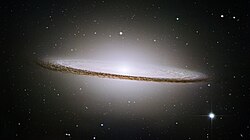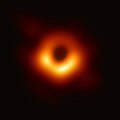Virgo (constellation)
Virgo is a zodiac constellation which lies on the celestial equator. It is between Leo (at west) and Libra (at east).This constellation is large; the constellation is the second biggest constellation you can see on the sky. Legends say Virgo is Astraea.
 Click for larger image | |
| List of stars in Virgo | |
| Abbreviation: | Vir |
| Genitive: | Virginis |
| Symbology: | |
| Right ascension: | 13 h |
| Declination: | −4° |
| Area: | 1294 sq. deg. (2nd) |
| Main stars: | 9, 15 |
| Bayer/Flamsteed stars: | 96 |
| Stars known to have planets: | 29 |
| Bright stars: | 3 |
| Nearby stars: | 10 |
| Brightest star: | Spica (α Vir) (0.98m) |
| Nearest star: | Ross 128 ( ly) |
| Messier objects: | 11 |
| Meteor showers: | Virginids Mu Virginids |
| Bordering constellations: | Boötes Coma Berenices Leo Crater Corvus Hydra Libra Serpens Caput |
| Visible at latitudes between +80° and −80° Best visible at 21:00 (9 p.m.) during the month of May | |
Location
Virgo is prominent in the spring sky in the Northern Hemisphere, visible all night in March and April. As the largest zodiac constellation, the Sun takes 44 days to pass through it, longer than any other. From 1990 and until 2062, this will take place from September 16 to October 30. It is located in the third quadrant of the Southern Hemisphere (SQ3) and can be seen at latitudes between +80° and -80°.
The bright star Spica makes it easy to locate Virgo, as it can be found by following the curve of the Big Dipper/Plough to Arcturus in Boötes and continuing from there in the same curve ("follow the arc to Arcturus and speed on to Spica").[1]
Due to the effects of precession, the autumn equinox point lies within the boundaries of Virgo very close to β Virginis. This is one of the two points in the sky where the celestial equator crosses the ecliptic (the other being the vernal equinox point in the constellation of Pisces). From the 18th century to the 4th century BC, the Sun was in Libra on the autumnal equinox, shifting into Virgo thereafter. This point will pass into the neighboring constellation of Leo around the year 2440.
Virgo (constellation) Media
The shadow of the central black hole in the galaxy Messier 87 in Virgo, obtained by the Event Horizon Telescope collaboration. This is the first direct image of a black hole.
Virgo as depicted in Urania's Mirror, a set of constellation cards published in London c.1825
The spiral galaxy NGC 5037
The elliptical galaxy Messier 87
This image from the NASA/ESA Hubble Space Telescope shows two of the galaxies in the galactic triplet Arp 248.
James Webb Space Telescope peers behind the bars to image the bright tendrils of gas and stars of the barred spiral galaxy NGC 5068. The galaxy lies around 17 million light-years from Earth in the constellation Virgo.
References
- ↑ "Night Sky~Big Dipper Navigation". Souledout.org. Retrieved 2012-05-16.
| Wikimedia Commons has media related to Lua error in Module:Commons_link at line 62: attempt to index field 'wikibase' (a nil value).. |










